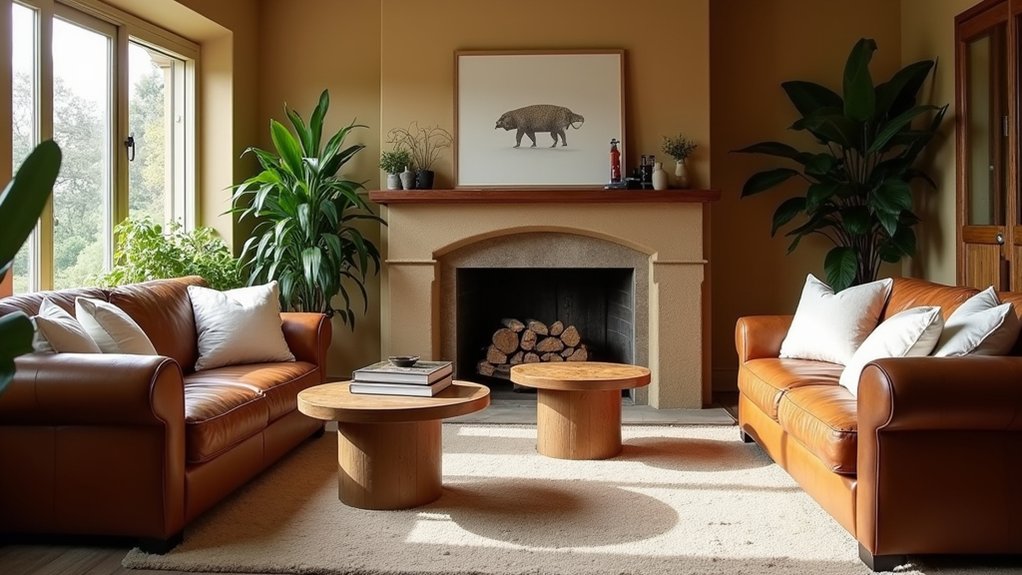
15 Brown and White Living Room Ideas That Are Balanced and Warm
A brown and white living room achieves balanced warmth by integrating muted earth tones, crisp creams, and contrasting textures such as plush velvet, jute, and natural fibers. Strategic use of white trim, wooden beams, and effortlessly layered textiles enhance light flow and spatial harmony. Brown leather accents, geometric rugs, and botanical elements ground the palette while keeping the ambience inviting and modern. Discover design ideas that refine color, texture, and architectural interplay for maximum comfort and style ahead.
Key Takeaways
- Combine cream or white furnishings with brown walls or accents to brighten the room and maintain a balanced, inviting atmosphere.
- Layer plush textiles like velvet pillows, woven throws, and jute rugs to add depth and tactile warmth without visual clutter.
- Use white trim, molding, and built-in shelves to highlight architectural features and create crisp contrast against brown surfaces.
- Incorporate a brown leather sofa with cozy neutral throws and cushions in varied textures for both warmth and visual interest.
- Maximize natural light with large windows and mirrors, preventing brown tones from feeling heavy and ensuring the space remains airy.
Decorate With Modern Earth Tones
When curating a brown and white living room, integrating modern earth tones—such as muted beige, camel, and latte—establishes a foundational palette that radiates warmth and visual cohesion.
Strategic placement of dark brown shelving and accent alcoves introduces visual contrast, enhancing spatial depth while adhering to a contemporary look.
Dark brown shelving and accent alcoves create striking contrast, adding depth and a refined, modern edge to your living space.
Carefully selected accessories in earth tones, including terracotta and rust, serve as nuanced highlights that intensify the room’s warm and inviting atmosphere without overwhelming the core brown and white scheme.
Opting for furniture with clean lines and subtle curves further reinforces the modern aesthetic, allowing the earth-toned palette to remain the visual anchor.
This approach seamlessly bridges the interior to the natural world, creating a tranquil environment that feels simultaneously sophisticated and grounded. Additionally, incorporating wooden elements like beams or tables can add warmth and texture, enhancing the overall coziness of the space.
Layer Textures for Depth and Warmth
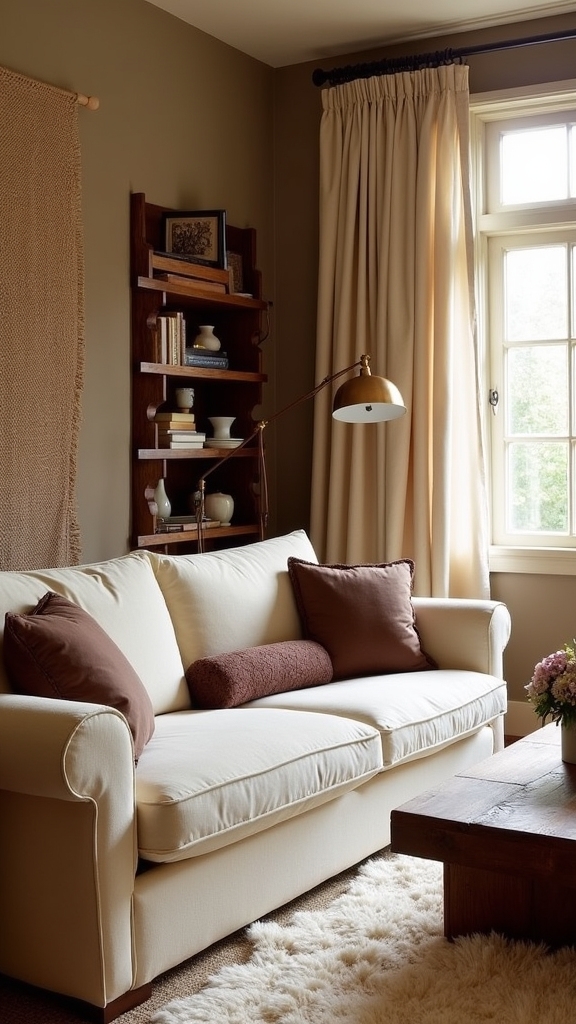
A curated interplay of plush velvets and woven textiles punctuates the brown and white palette, introducing tactile distinction and layered visual appeal. Matte surfaces juxtaposed with glossy accents, such as lacquered tables or metallic décor, create dimensional interplay across the room’s spatial planes. Integrating natural fibers—like jute rugs or linen throws—grounds the composition, fostering cohesion and sensory warmth. Thoughtful interplay of textures enhances depth and personality in the living room, establishing a balanced and inviting environment.
Mix Plush and Woven
Texture becomes a defining element in brown and white living rooms, where plush velvet cushions meet woven jute rugs to create multidimensional interest.
The strategic mix of plush and woven textures visually enlivens the space, while warm tones accentuate a cozy atmosphere. A sophisticated interplay of materials guarantees an inviting environment, balancing tactile sensation with visual depth.
Expertly layering surfaces and finishes enhances spatial awareness and brings warmth to minimalist palettes.
- Plush upholstery—velvet or chenille—contrasts beautifully against woven rattan or wicker furniture, anchoring the space.
- Knitted throws draped over woven armchairs introduce softness and layered comfort.
- Textured wall hangings juxtaposed with smooth surfaces soften the overall composition.
- Jute area rugs ground the room, lending organic warmth to the brown and white backdrop.
Combine Matte and Gloss
Harnessing the interplay between matte and gloss finishes enhances spatial dynamics in a brown and white living room.
Expertly balanced, matte surfaces—such as brown walls or plush furnishings—anchor the environment with a warm, inviting foundation. Gloss finishes, found in white ceramic vases or glass decor, reflect ambient light, creating openness and movement within the space.
This deliberate juxtaposition in textures prevents monotony, introducing layers of visual interest that draw the eye and define zones within the room. Matte textiles like velvet or linen cushions contrast effectively with glossy elements, emphasizing both tactile richness and luminous highlights.
The result is a sophisticated composition: depth, warmth, and a sense of refinement, ensuring the living room remains both comfortable and visually compelling.
Add Natural Fibers
Jute rugs underfoot and linen drapes at the window introduce tactile contrast and organic warmth to a brown and white living room.
The expert use of natural fibers enhances the textural palette, harmonizing earthy tones with crisp whites. Spatial awareness is heightened through intentional layering, which delivers both visual depth and sensory dimension.
To achieve a sophisticated interplay of texture and warmth, consider:
- Jute or sisal rugs: These foundational elements ground the room in natural fibers, softening white expanses and enhancing earthy tones.
- Layered textiles: Cotton, linen, and velvet cushions introduce nuanced texture, building spatial richness.
- Wooden elements: Mahogany or oak furnishings contribute organic textures, reinforcing the room’s warmth.
- Woven baskets: Decorative yet functional, they punctuate the space with tactile intrigue and additional layered textiles.
Highlight White Architectural Details
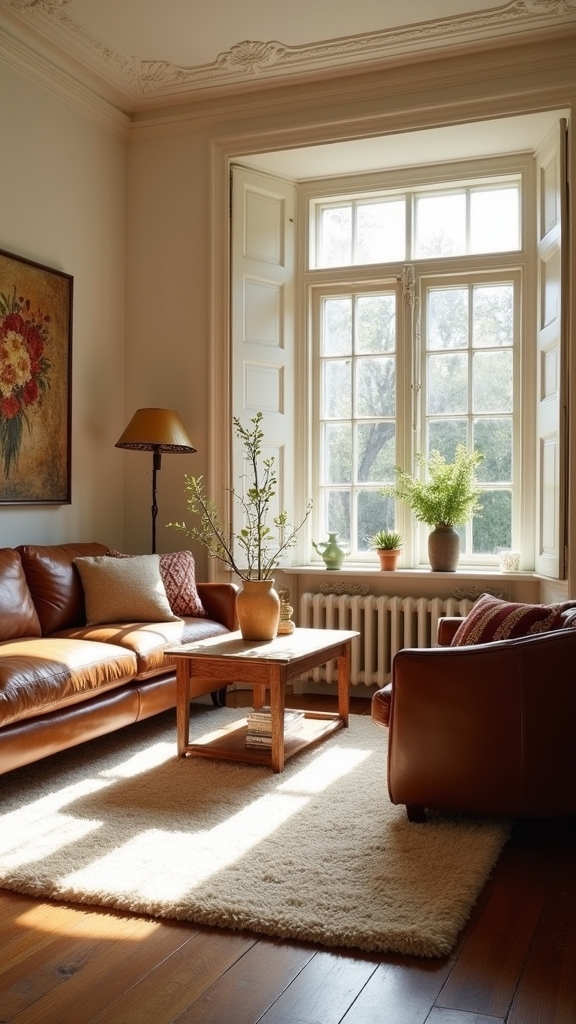
Emphasizing white trim and molding against brown walls articulates architectural lines and amplifies contrast within the space. Highlighting built-in shelves in a crisp white finish creates visual focal points and accentuates both storage and display areas. Accentuating ceiling beams with a white palette further enhances verticality and introduces structural rhythm to the living room environment. Adding decorative columns can enhance the aesthetic appeal and provide a sophisticated touch to the architectural details of the space.
Emphasize Trim and Molding
Crisp white trim and meticulously crafted molding act as architectural punctuation in a brown and white living room, providing sharp linear contrasts that draw the eye to the room’s structural features.
Utilizing white trim against brown tones creates an interplay that heightens both color and form, ensuring the space feels balanced and visually dynamic. These elements not only highlight the architectural features but also cultivate an inviting, cozy atmosphere.
Expertly applied, white molding refines sightlines and enhances spatial awareness. For ideal effect:
- Install crown molding to emphasize ceiling height and grandeur.
- Use white baseboards to define the shift between floor and wall.
- Incorporate wainscoting for a tactile, layered backdrop behind brown furnishings.
- Frame windows and doors with white trim to punctuate openings and amplify natural light.
Showcase Built-In Shelves
When integrated thoughtfully, built-in shelves become architectural focal points in a brown and white living room, merging utility with visual sophistication. Strategic use of white accents on built-in shelves juxtaposed against brown tones amplifies both depth and spatial clarity. White architectural details—when aligned with existing trim or molding—establish a unified design language, enriching the room’s warm color palette. Integrated shelf lighting accentuates white features, emphasizing architectural details and offering a luminous contrast that visually expands the space. The interplay between brown shelving and white backing cultivates tactile interest while maintaining equilibrium.
| Design Element | Impact on Space |
|---|---|
| White Shelf Accents | Enhances brightness, increases openness |
| Brown Shelving | Grounds the palette, adds warmth |
| Integrated Lighting | Highlights architectural details |
| Cohesive White Trim | Unifies design, sharpens visual lines |
Accentuate Ceiling Beams
A single row of white ceiling beams draws the gaze upward, establishing a dynamic interplay between vertical and horizontal planes in a brown and white living room.
The crisp white beams create a striking contrast against brown walls, amplifying both architectural depth and visual interest. Strategic use of white beams not only enhances the perceived spatial volume but also accentuates the room’s inviting atmosphere by reflecting natural light across surfaces.
For a cohesive and sophisticated look, consider the following:
- Position white beams evenly for balanced symmetry against brown walls.
- Incorporate lighting fixtures as decorative features to highlight architectural elements.
- Pair white beams with warm brown tones to maintain equilibrium and avoid color dominance.
- Select complementary artwork that echoes the contrast and spatial rhythm established by the beams.
Choose a Brown Leather Sofa
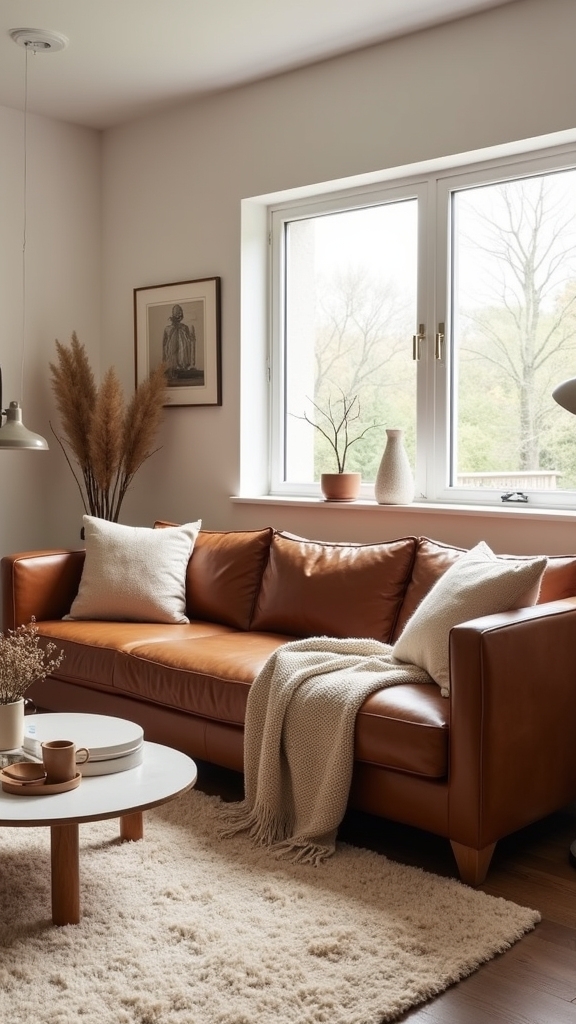
Central to a harmonious brown and white living room, the brown leather sofa introduces a sophisticated tactile contrast that anchors the space. Its smooth, lustrous surface offers a visual focal point, establishing both structure and warmth within the room’s palette. Tan variations of the brown leather sofa particularly enhance contemporary aesthetics, allowing for seamless integration with crisp white walls and modern decor accents. To heighten spatial comfort, layering cozy throws in warm colors across the sofa softens its profile and cultivates an inviting feel. Contrasting fabric cushions—cotton or linen—add dimensionality and textural complexity. Faux leather options deliver the same refined presence while aligning with budget-conscious and ethical considerations. Incorporating earthy neutrals like brown and cream as accent colors further enhances the inviting ambiance and warmth of the living space. This versatile centerpiece underpins the overall cohesion and welcoming tone of the living area.
Add Warmth With Wooden Elements
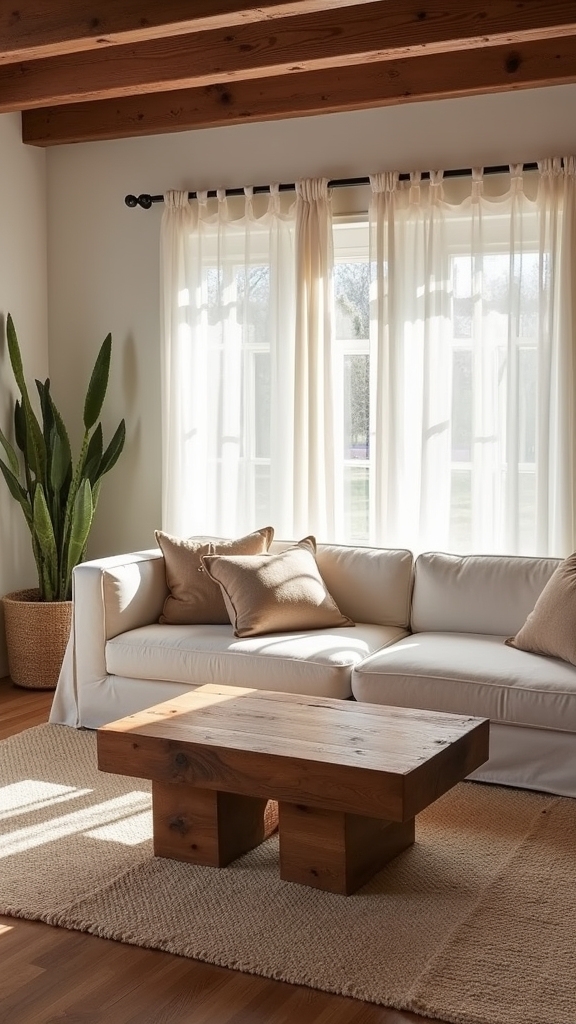
Though the brown leather sofa establishes a strong foundation, introducing wooden elements enhances the textural complexity and natural warmth of the living room.
The interplay between natural wood finishes and the brown and white palette curates a refined yet cozy atmosphere.
Spatial strategy is key; the selection and placement of wooden accents can transform the sensory experience of the space.
Consider the following expert applications:
- Opt for light woods, such as oak or maple, to amplify brightness and maintain an airy ambiance.
- Incorporate dark woods like walnut or mahogany for depth and visual intrigue.
- Use wooden beams or wall paneling to create architectural interest and a striking focal point.
- Select wooden coffee tables, shelving, or decor to layer warmth and tactile appeal throughout the room.
- Incorporating wooden furniture like farmhouse tables can add warmth and charm, enhancing the rustic appeal of the living space.
Incorporate Natural Finishes and Accents
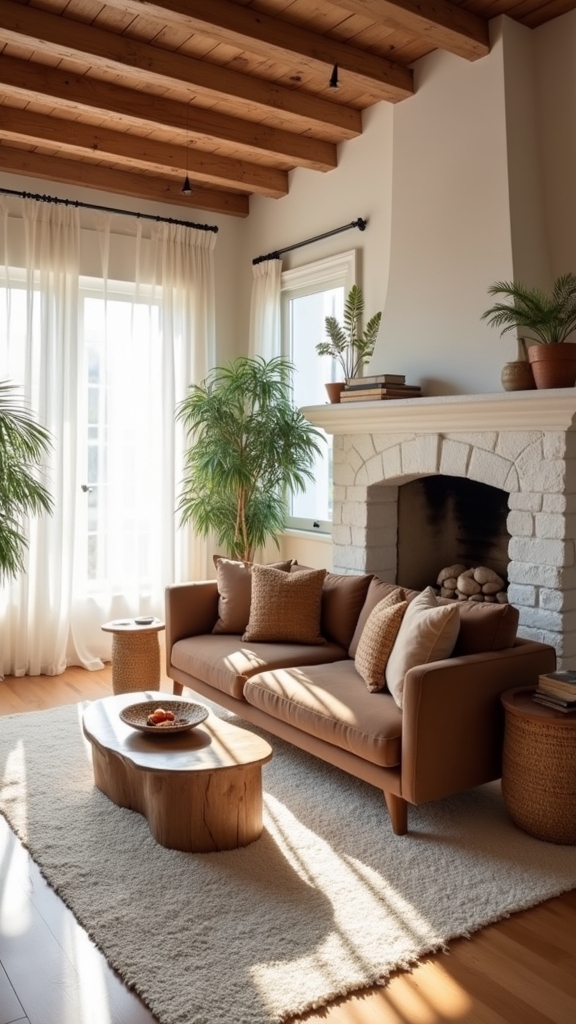
Integrating wooden elements such as oak or maple furnishings introduces organic warmth and structural contrast within a brown and white living room. The addition of woven textures—jute rugs, rattan baskets, or cane accents—enriches the tactile scenery and enhances visual layering. Together, these natural finishes establish a cohesive, inviting environment grounded in material authenticity. Consider adding vintage and rustic accents like farmhouse mirrors and antique furniture to enhance the room’s character and achieve a timeless aesthetic.
Embrace Wooden Elements
A solid oak coffee table or walnut flooring introduces an immediate sense of grounding to a brown and white living room, anchoring the space with natural warmth and refined texture.
The interplay of wooden elements enriches the tactile experience, establishing a visual equilibrium between the earthy brown palette and crisp white surfaces.
To maximize design cohesion and aesthetic sophistication, consider the following approaches:
- Select wooden furniture in natural finishes to infuse organic texture and visual depth.
- Integrate reclaimed wood shelving or decorative objects, lending character and sustainable appeal.
- Utilize wooden accents strategically to break up expanses of white, introducing contrast and definition.
- Layer various wood tones—such as espresso, honey, or driftwood—within the brown spectrum to cultivate dimensionality and a serene, harmonious environment.
This approach guarantees an inviting, balanced living space.
Add Woven Textures
Enhance the tactile and visual appeal of a brown and white living room by introducing woven textures that bridge organic warmth with minimalist clarity.
Expertly curated woven textures—such as rattan, jute, or wicker—infuse dimension and a grounded sensibility, complementing the interplay of brown and white. Employing natural finishes in key furnishings like wooden coffee tables or sideboards unifies the palette, while accent pieces such as woven baskets or artisanal wall hangings punctuate the space with purposeful texture.
Layered rugs in materials like jute or sisal delineate zones, contributing both comfort and visual depth, mitigating any sterility associated with a stark neutral scheme. Soft furnishings in woven textiles further soften the environment, producing an inviting, harmonious atmosphere that enhances the living room’s spatial cohesion.
Accessorize With Crisp White and Cream
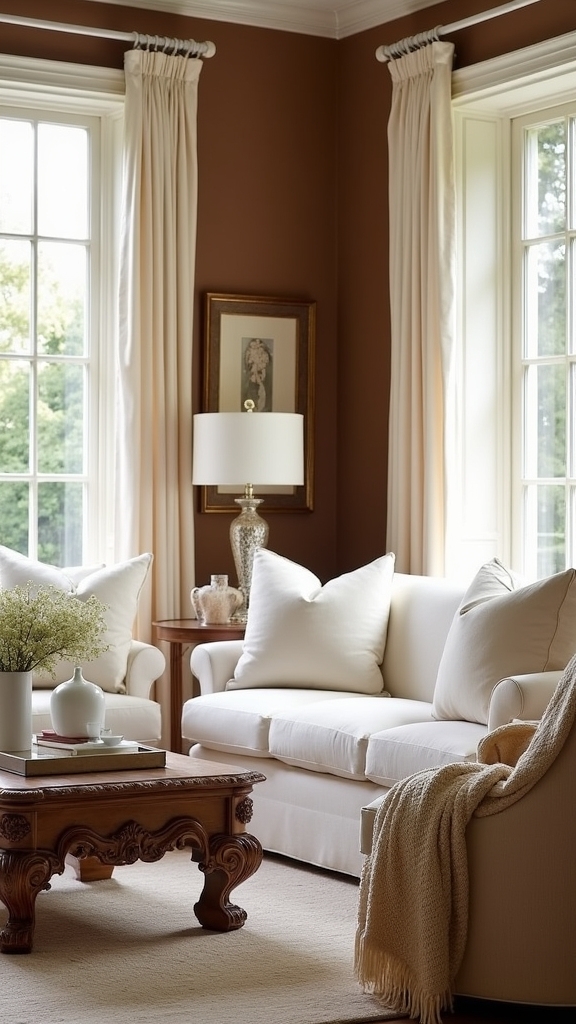
When crisp white and cream accents are introduced into a brown living room, the interplay of light and dark tones immediately enhances the spatial dynamic. To expertly accessorize, use these hues as deliberate counterpoints: their reflective properties amplify natural light, creating visual balance while accentuating the inherent warmth of brown. Employing a layered approach cultivates both depth and cohesion. Consider the following strategies:
- Position crisp white throw pillows and cream blankets on brown sofas for a tactile and luminous effect.
- Integrate white or cream area rugs to visually expand the space and define seating zones.
- Select decorative accessories—such as vases, frames, and sculptural objects—in white or cream to punctuate brown surfaces.
- Layer multiple shades of white and cream, ensuring each accessory interacts harmoniously with the brown palette.
- Incorporate textures like velvet or faux fur in your accessories to add richness and enhance comfort.
Introduce Patterned Rugs in Brown and White
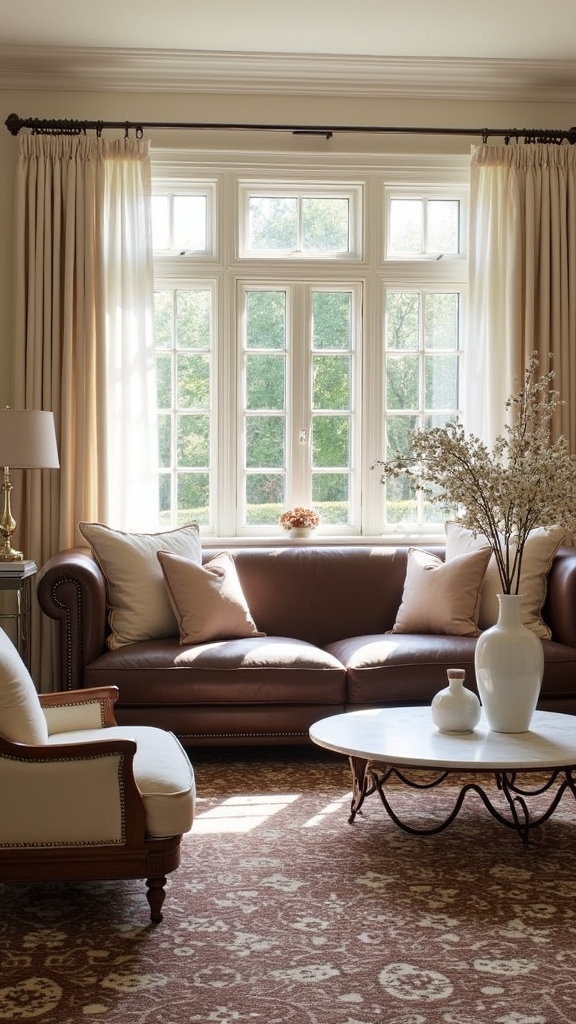
Patterned rugs in brown and white offer a sophisticated method for anchoring the living room, introducing both visual rhythm and tactile contrast. Selecting geometric or abstract motifs guarantees cohesion with modern design, while strategic layering enhances spatial definition and depth. The interplay of pattern and texture serves to unify seating areas and amplify the room’s dimensionality. Incorporating textured paint finishes such as suede or sand can further enhance the earthy vibe of the space, providing a unique and cohesive aesthetic.
Choosing Rug Patterns
Although the living room’s color palette may already convey warmth, introducing a brown and white patterned rug strategically grounds the space and establishes a cohesive visual anchor.
Expertly chosen rug patterns serve as the nexus between brown decor elements and the room’s overall ambiance, amplifying warm tones while imparting texture and depth to the visual field.
To optimize spatial harmony and enhance the layered look, discerning homeowners should consider the following:
- Select geometric or abstract patterns for a modern sensibility; traditional motifs enhance rustic or vintage themes.
- Opt for jute or wool compositions to introduce tactile richness and resilience.
- Employ varying shades of brown and white to prevent monotony and cultivate subtle visual interest.
- Prioritize durability and ease of maintenance, ensuring longevity and ongoing aesthetic appeal amid daily activity.
Layering for Visual Depth
Building upon the thoughtful selection of rug patterns, layering becomes an advanced technique for achieving visual depth in a brown and white living room.
By strategically placing a patterned rug—featuring geometric or abstract motifs—over a solid brown or neutral base carpet, one introduces a dynamic interplay of patterns and textures. This spatial arrangement not only delineates functional zones within the open plan but also amplifies visual interest without overwhelming the palette.
Layering rugs in varying shades of brown and white fosters harmony and continuity, uniting disparate elements under a cohesive design language. The tactile nature of multiple rug layers contributes added warmth, softening the overall ambiance while enhancing the sensory experience.
This method transforms the floor into a curated canvas, enriching both depth and warmth.
Mix in Modern Industrial Touches
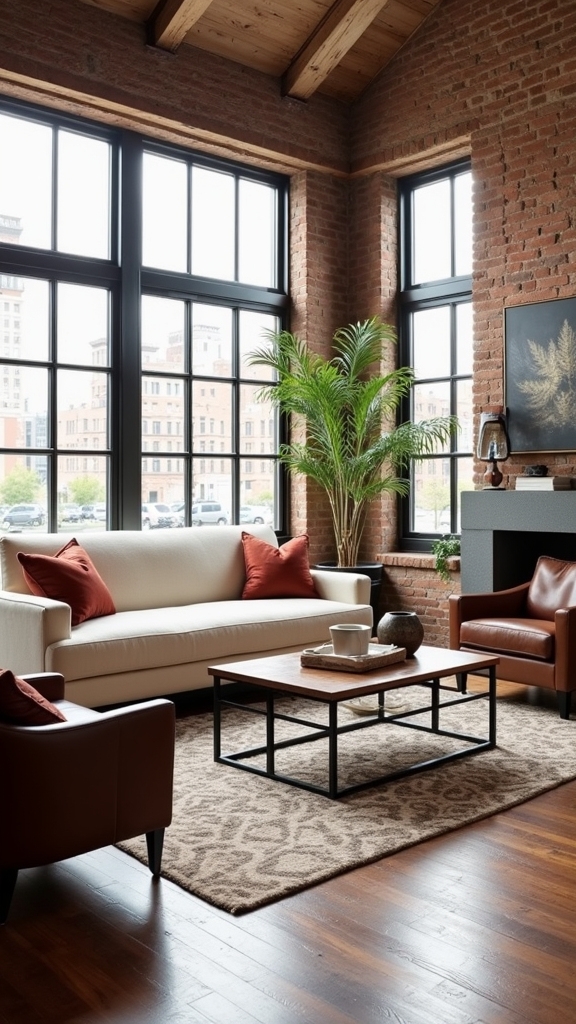
Exposed brick walls and metal accents seamlessly introduce a modern industrial edge to a brown and white living room, balancing the warmth of the color palette with raw, tactile materials.
The interplay of brown and white serves as a refined backdrop for industrial-inspired features, emphasizing spatial clarity and textural contrast. Achieving a harmonious composition requires strategic placement of furnishings and finishes.
Consider the following approaches:
- Select dark brown leather furniture to infuse sophistication and rugged texture against crisp white surfaces.
- Incorporate industrial lighting—such as pendant fixtures or metal sconces—for architectural focal points and atmospheric depth.
- Integrate wooden elements in distressed or deep finishes, amplifying the visual narrative of brown and white.
- Embrace an open, uncluttered layout, ensuring the industrial motif enhances rather than overwhelms the living area’s balance.
- Use metallic accents like brass or chrome to elevate minimalist decor and add edgy glamour to the living room.
Pair Brown and White With Blue Accents
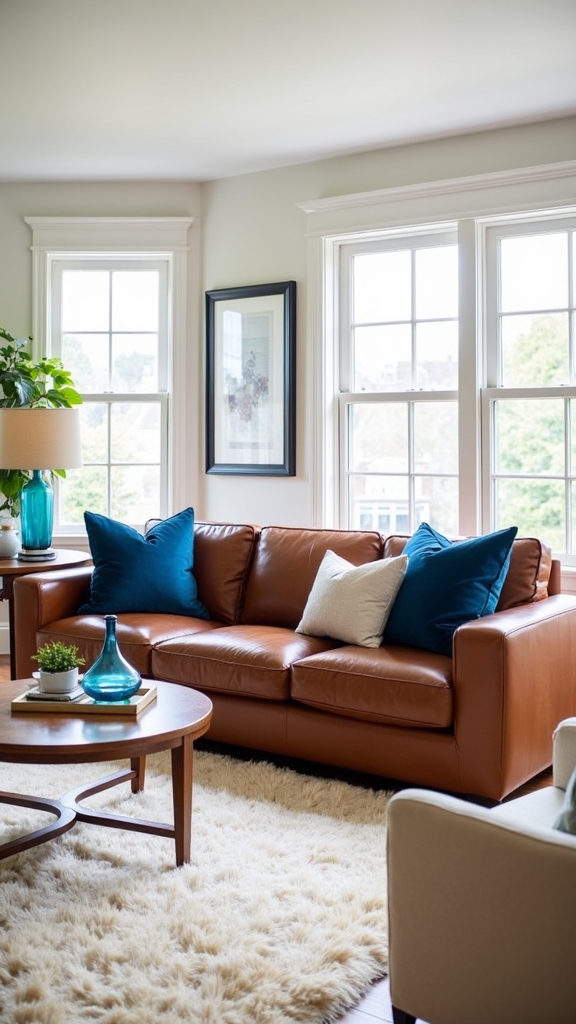
When shades of blue are introduced to a brown and white living room, the interplay of cool and warm tones generates a visually dynamic environment with distinct spatial clarity. Earthy brown furnishings anchor the space, while crisp white walls provide a balanced backdrop that amplifies ambient light. Blue accents—whether in the form of cushions, vases, or artwork—deliver striking visual punctuation, infusing the room with invigorating contrast and a hint of coastal vibrancy. The incorporation of natural materials, such as jute and rattan, reinforces the organic, warm tones and enhances overall textural depth. Strategic color blocking with blue accents adds dimension, ensuring the palette remains cohesive yet intriguing. Incorporating layered lighting techniques can further enhance the ambiance, adding warmth and depth to the living room design.
| Brown Foundation | White Backdrop | Blue Accents |
|---|---|---|
| Sofa, wood table | Walls, rugs | Cushions, vases |
| Earthy warmth | Spatial clarity | Visual emphasis |
| Textural depth | Light reflect | Coastal contrast |
Use Soft Furnishings in Coordinating Hues
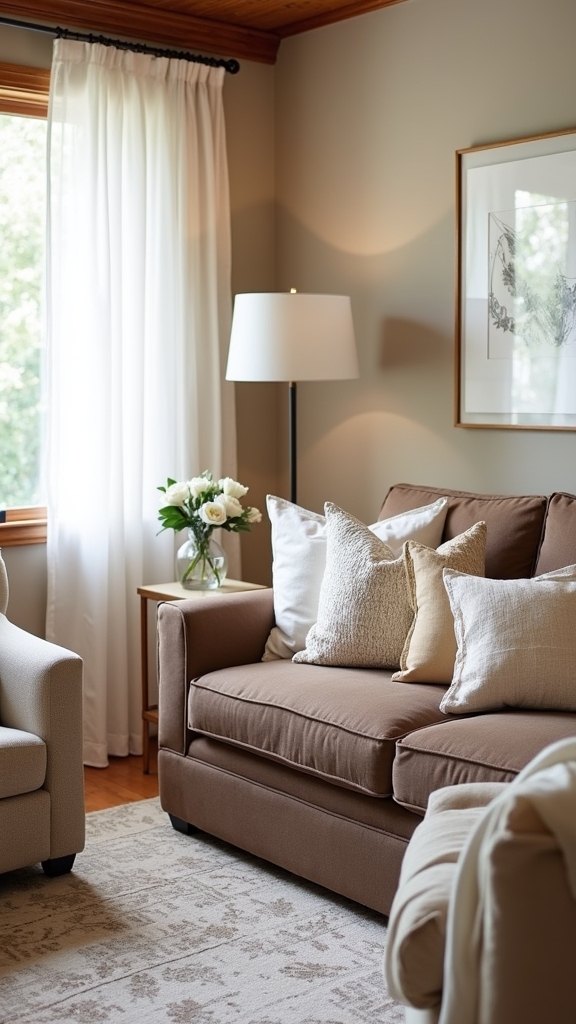
Through the strategic use of soft furnishings in coordinated brown and white hues, a living room achieves both visual harmony and tactile richness.
Designers utilize these elements to enhance spatial cohesion while amplifying comfort and style. Employing a brown and white palette in cushions, throws, and rugs introduces warm tones that balance the crispness of white with the grounding effect of brown.
Key expert recommendations include:
- Select textiles—such as velvet or linen—that impart texture and depth, elevating the sensory experience.
- Layer patterns and tactile weaves within the brown and white spectrum to generate visual interest and prevent monotony.
- Integrate a gradient of light and dark browns in soft furnishings for dynamic contrast.
- Rotate seasonal textiles to adapt warmth or brightness while maintaining palette unity.
Set the Scene With Woodland or Nature-Inspired Wallpaper
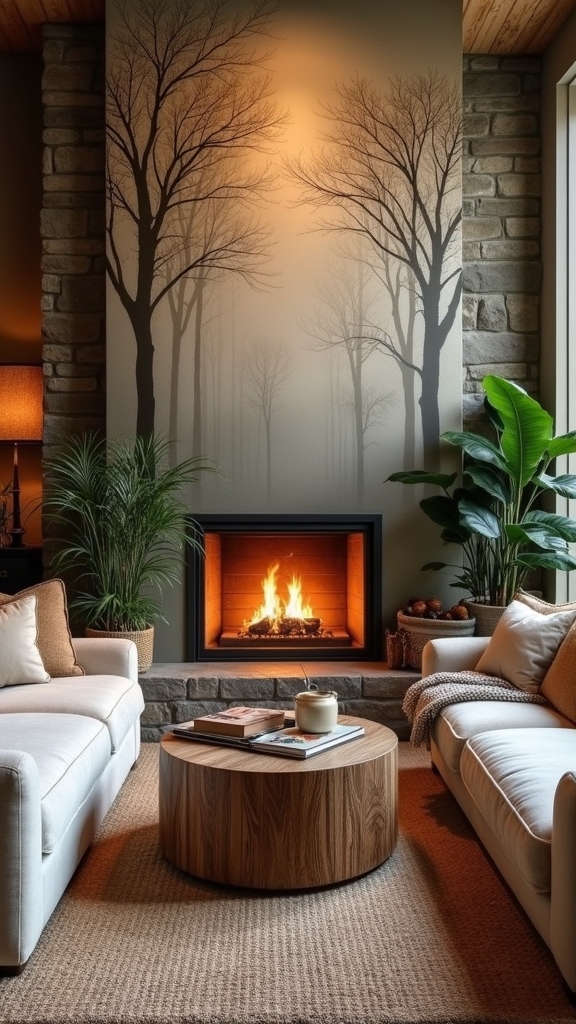
To further enhance the tactile and visual layers established by soft furnishings, designers often introduce woodland or nature-inspired wallpaper as a dramatic backdrop in brown and white living rooms.
Thoughtfully selected wallpaper featuring motifs such as trees, leaves, or subtle wildlife infuses the space with visual interest and depth, while reinforcing the organic palette’s earthy tones.
Lighter brown hues within the design can reflect ambient light, preserving a warm, cohesive environment that harmonizes with crisp white furnishings.
Textured or metallic-accented wallpaper options boost the sensory experience, contributing a sophisticated dimension to the spatial composition.
Strategically positioned, nature-inspired wallpaper serves as a focal point, drawing the eye and creating a seamless connection between interior space and the tranquil allure of the outdoors.
Create a Reading Nook With Taupe and White
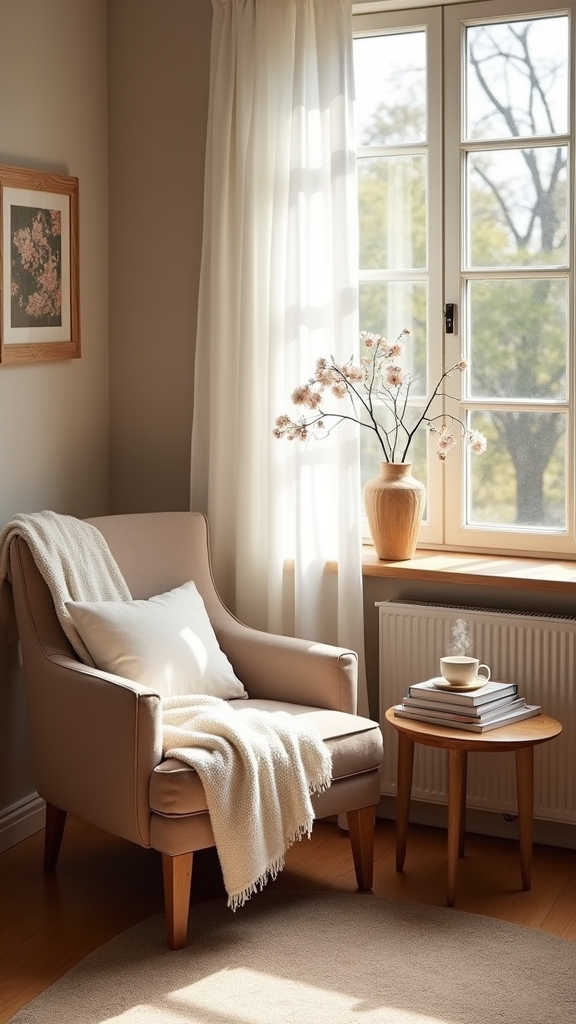
Nestled within the larger living space, a reading nook defined by taupe walls and crisp white accents cultivates a calming enclave that balances warmth with clarity.
The interplay of brown undertones in the taupe envelops the area, while white details amplify natural light, resulting in a tranquil retreat for quiet moments.
Expertly curated elements emphasize both visual harmony and tactile comfort:
- Seating: A taupe velvet armchair enhances comfort, paired with a lightweight white throw for textural contrast.
- Lighting: Placement near a window, enhanced by sheer white curtains, permits filtered sunlight, enriching the ambiance.
- Surfaces: A compact bookshelf or side table in a brown wood finish anchors the space functionally and aesthetically.
- Flooring: Layering a light jute or shag rug introduces softness underfoot, completing this serene reading nook.
Style With Plants and Biophilic Elements
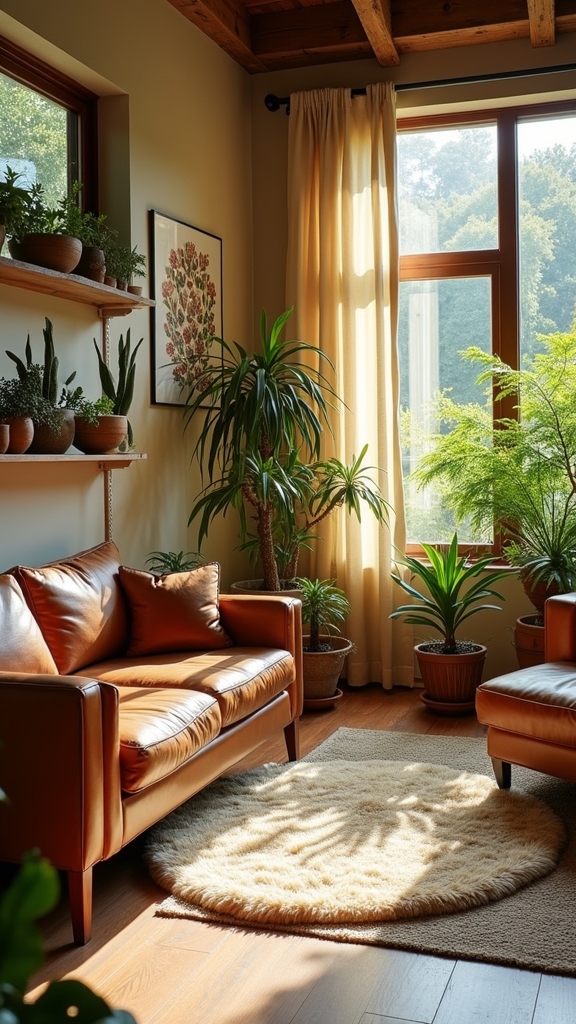
While natural light filters through expansive windows, the introduction of indoor plants—such as ferns, snake plants, and peace lilies—strategically animates a brown and white living room with organic energy.
The deliberate placement of greenery near light sources not only supports plant health but also bolsters biophilic design principles, encouraging a harmonious connection with nature.
Incorporating indoor plants in earthy-toned pots or textured vessels enhances the visual dialogue between living botanicals and the grounding brown palette.
Natural wood furniture, with its inherent warmth and tactile grain, anchors the space, fostering a cohesive interplay between earthy tones and crisp white surfaces.
Woven textiles and plant arrangements together cultivate a layered ambiance, where serenity and balance prevail within the spatial composition of the brown and white living room.
Balance Brown Tones With Light, Airy Layouts

Balanced composition in a brown and white living room relies on spatial openness and thoughtful contrasts. Achieving a balanced, light, and airy atmosphere requires strategic manipulation of both color and layout to guarantee brown tones remain warm without dominating the space.
Design experts emphasize visual flow and spatial equilibrium through the following principles:
- Opt for light-colored furnishings, such as cream sofas, to provide stark contrast against richer brown elements, enhancing the room’s luminosity.
- Utilize large windows or well-placed mirrors to amplify natural light, which accentuates the warmth of brown tones while preventing visual heaviness.
- Incorporate layered textures—soft white textiles paired with brown leather—adding depth while maintaining an airy sensibility.
- Select light brown accents, like wooden tables or neutral rugs, to unify the palette and sustain a cohesive, inviting environment.
Frequently Asked Questions
What Is the 2/3 Rule for Living Rooms?
The 2/3 rule for living rooms optimizes color balance by assigning two-thirds to a dominant hue across major furniture placement and texture layering, while accent pieces and strategic lighting options complete the palette, ensuring visual emphasis and spatial coherence.
What Color Goes Well With Brown for a Living Room?
When selecting colors to complement brown in a living room, designers recommend beige accents and cream cushions for softness, navy blue for visual depth, gold embellishments for luxury, and green plants to introduce organic vibrancy and spatial freshness.
How to Brighten up a Brown Living Room?
To brighten a brown living room, one should introduce light accents and airy textiles, utilize reflective surfaces like mirrors, incorporate vibrant artwork, and strategically place bright accessories. This combination enhances spatial luminosity and boosts visual interest throughout the space.
How Do You Make a Brown Living Room Pop?
To make a brown living room pop, designers recommend integrating bold accent colors, layered textured fabrics, and statement artwork. Strategic lighting options and curated furniture choices create dynamic focal points, enhancing spatial flow and emphasizing visual contrast within the environment.
Conclusion
Incorporating brown and white into living room design achieves harmonious spatial balance and visual warmth. Through expert layering of textures, strategic use of earth tones, and integration of natural materials such as wood and leather, each element contributes to a cohesive environment. Crisp white architectural details contrast beautifully with rich browns, enhancing light diffusion and room depth. Thoughtful placement of biophilic accents and nature-inspired motifs further raises comfort, resulting in a sophisticated, inviting, and spatially dynamic living area.
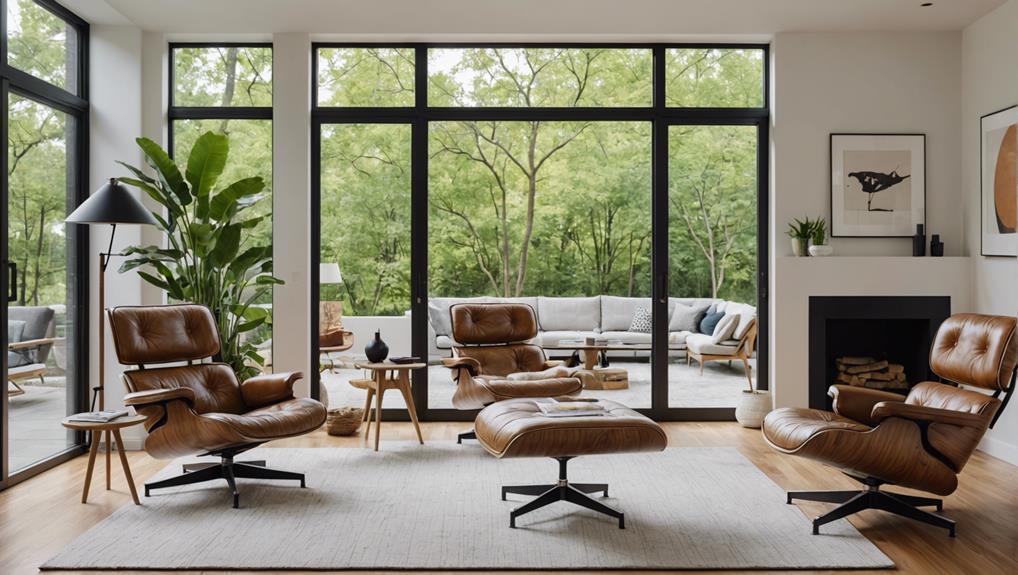
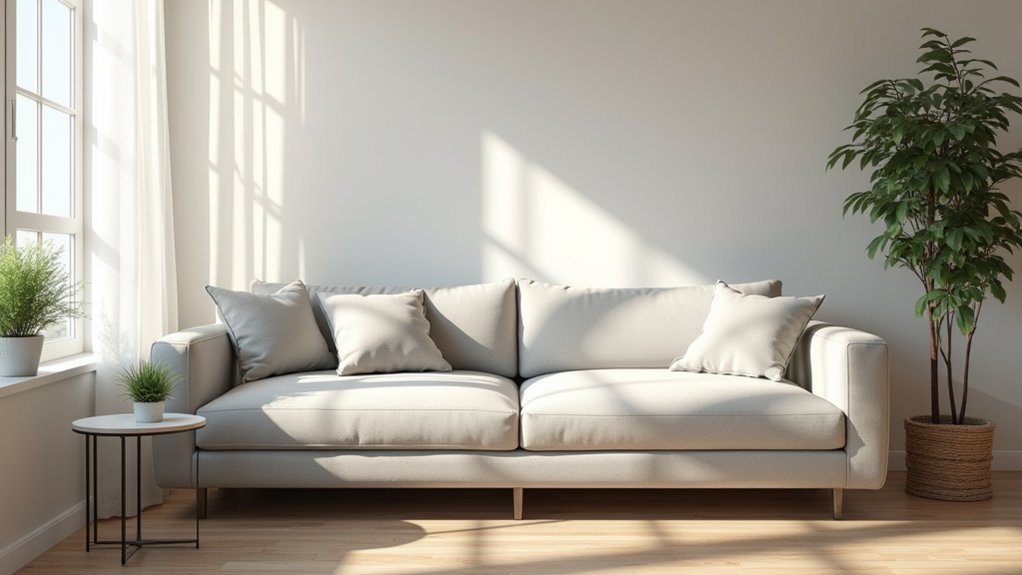
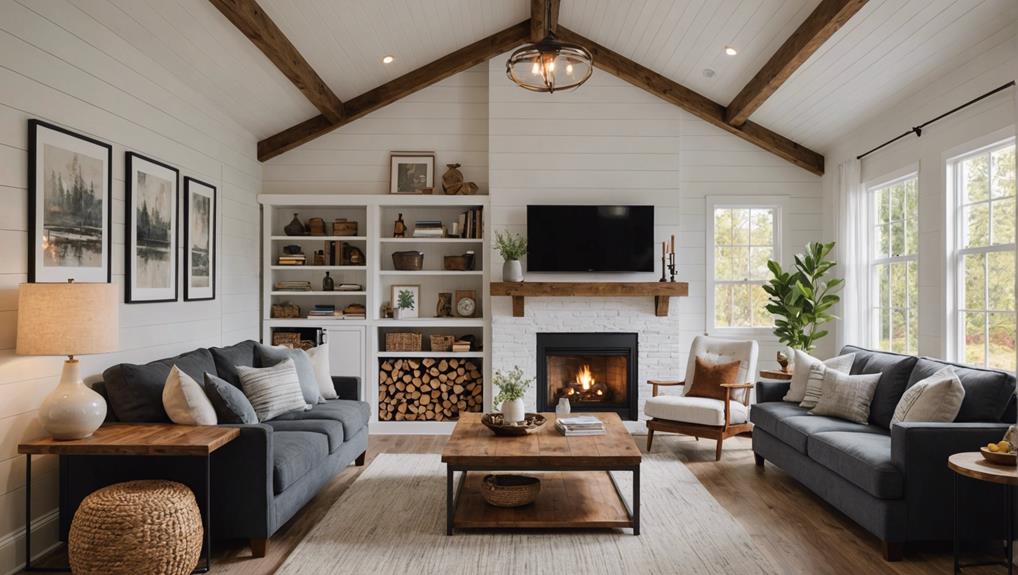
Leave a Reply